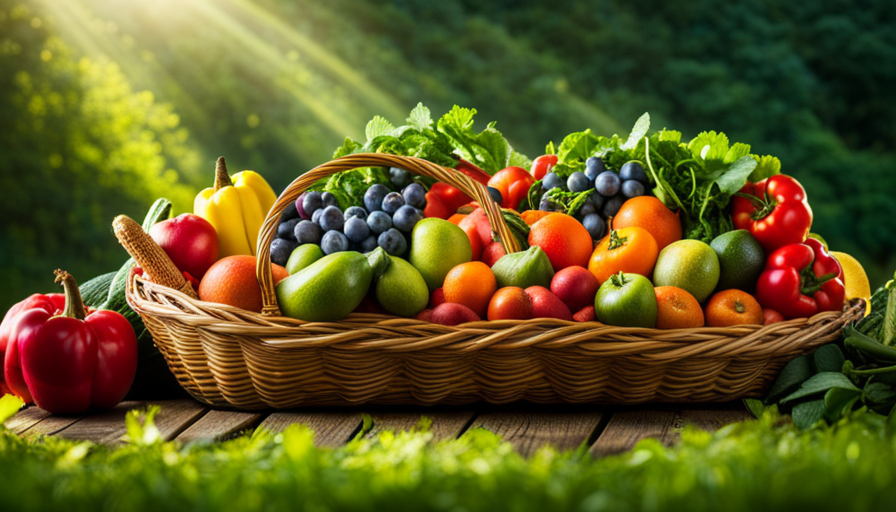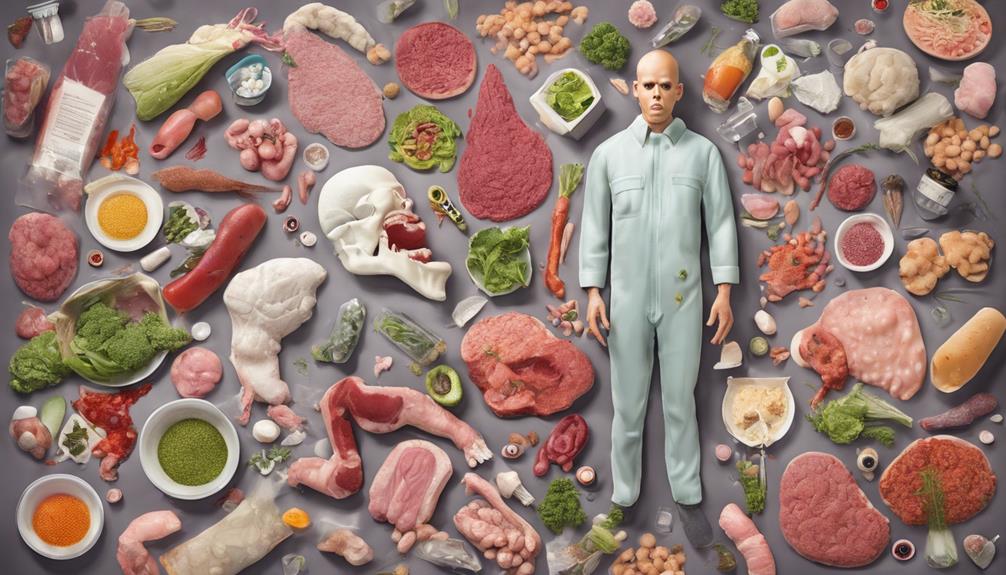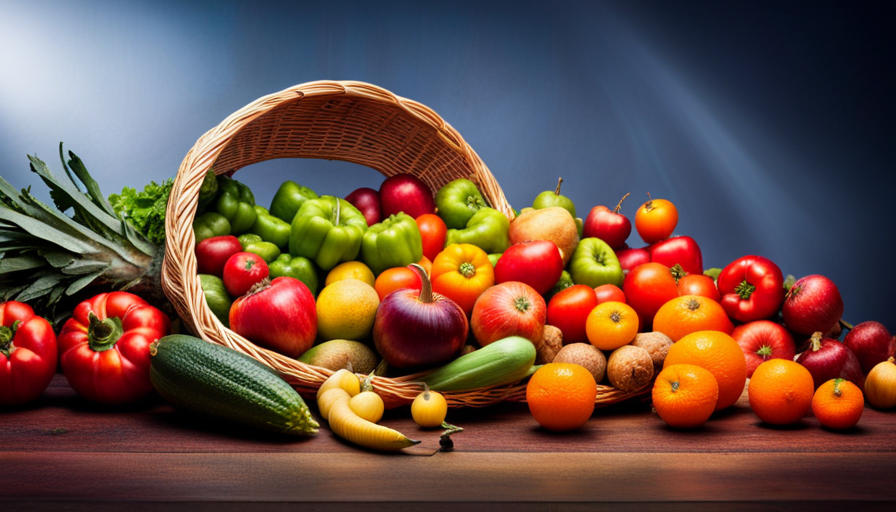Are you prepared to explore the realm of raw food? Get ready for an amazing adventure that offers the potential for peak health and energy.
The raw food diet, with its promise of pure, unadulterated nourishment, has captured the attention of health enthusiasts worldwide. But before we plunge headfirst into this seemingly idyllic dietary paradise, let’s take a moment to explore a burning question: is the raw food diet sustainable?
In this article, we will peel back the layers of this captivating dietary trend and examine it through a critical lens. We will delve into the nutritional requirements and challenges, food safety concerns, environmental impact, availability and accessibility of raw foods, long-term adherence and sustainability, weight management, energy levels, cultural and social considerations, and the importance of personalization and flexibility.
By addressing these key factors, we hope to shed light on whether the raw food diet can truly stand the test of time. So, fasten your seatbelts, and let’s embark on this thought-provoking exploration together.
Key Takeaways
- Raw food diet offers the promise of optimal health and vitality, capturing the attention of health enthusiasts worldwide.
- Proper meal planning is crucial for meeting nutrient needs and addressing challenges of protein intake and possible nutrient deficiencies.
- Food safety concerns with raw food include the risk of contamination and the need for proper food preparation, hygiene, handling, and storage.
- Long-term adherence to a raw food diet requires commitment, discipline, education, support, personalization, flexibility, and finding variety in meals, as well as addressing social implications and nutritional adequacy challenges.
Nutritional Requirements and Challenges
You might be wondering, ‘Are you getting all the nutrients you need on a raw food diet?’ It’s a valid concern, as nutritional guidelines emphasize the importance of a well-balanced diet that includes a variety of food groups.
While a raw food diet can provide many essential nutrients, it can be challenging to meet all the requirements. Meal planning becomes crucial to ensure adequate intake of macronutrients like carbohydrates, proteins, and fats, as well as micronutrients like vitamins and minerals.
One potential challenge of a raw food diet is obtaining enough protein. While sources like nuts, seeds, and legumes can provide plant-based protein, it may require careful planning to ensure sufficient intake. Additionally, certain nutrients like vitamin B12, which is primarily found in animal products, may be lacking in a raw food diet. Supplementation or including fortified foods may be necessary to meet these nutritional needs.
Transitioning into the subsequent section about food safety concerns, it’s important to note that while a raw food diet can offer health benefits, there are also potential risks.
Food Safety Concerns
Although there are legitimate concerns about the safety of consuming uncooked ingredients, it’s important to consider the potential risks associated with a raw food lifestyle.
One of the main concerns with raw food is the increased risk of foodborne illnesses. Raw ingredients, such as fruits, vegetables, and nuts, can harbor harmful bacteria like Salmonella, E. coli, and Listeria. These pathogens can cause severe gastrointestinal symptoms and, in some cases, be life-threatening. Proper food preparation becomes crucial in minimizing the risk of contamination. Thoroughly washing fruits and vegetables, using clean utensils and cutting boards, and practicing good hygiene are essential steps in reducing the chances of foodborne illnesses.
Furthermore, the raw food diet may also present challenges in terms of food handling and storage. Raw foods are more prone to spoilage due to their lack of preservatives and the absence of cooking, which can kill bacteria. It is important to properly store raw ingredients at the appropriate temperatures to prevent bacterial growth. Additionally, cross-contamination between raw and cooked foods should be avoided to prevent the spread of harmful bacteria.
While the raw food diet can provide numerous health benefits, it is important to be aware of the potential food safety concerns. By following proper food handling and storage practices, the risks of foodborne illnesses can be minimized.
Transitioning into the subsequent section about the environmental impact, it’s also important to consider the impact of a raw food lifestyle on the environment.
Environmental Impact
When it comes to the environmental impact of embracing a raw food lifestyle, it’s important to consider how your choices affect the planet. The raw food diet can have a lower carbon footprint compared to a traditional Western diet due to its emphasis on plant-based foods. Plant-based diets generally require fewer resources and produce fewer greenhouse gas emissions compared to diets that include animal products. However, it’s important to note that the environmental impact of the raw food diet can vary depending on factors such as transportation, packaging, and agricultural practices.
One way to reduce the environmental impact of a raw food diet is to focus on consuming locally sourced and seasonal produce. This reduces the carbon emissions associated with long-distance transportation and supports local farmers. Additionally, choosing organic produce can minimize the use of harmful pesticides and promote healthier agricultural practices.
To emphasize the importance of these choices, consider the following table:
| Raw Food Choices | Environmental Impact |
|---|---|
| Locally sourced | Reduced carbon emissions |
| Seasonal produce | Supports local farmers |
| Organic produce | Promotes healthier agricultural practices |
Considering the environmental impact of your food choices is crucial when adopting a raw food lifestyle. However, it’s also important to consider the availability and accessibility of raw foods in order to make sustainable choices.
Availability and Accessibility of Raw Foods
Given the rising popularity of the raw food lifestyle, it’s crucial to consider the accessibility and availability of nutrient-rich, unprocessed ingredients in order to fully embrace this holistic approach to nutrition.
While raw foods are generally available in most grocery stores, there are certain challenges when it comes to finding a wide variety of fresh, organic produce year-round. Availability can vary depending on location, with individuals in urban areas often having more options than those in rural areas.
Additionally, some raw food enthusiasts may face difficulty in finding specialty items like sprouts, nuts, and seeds, which are essential for a balanced raw food diet.
Cost concerns also play a role in the accessibility of raw foods. Fresh, organic produce can be more expensive than processed or conventionally grown alternatives. This can make it difficult for individuals on a tight budget to sustain a raw food diet long-term. However, there are ways to mitigate this issue, such as buying in bulk, shopping at local farmers’ markets, or growing your own produce.
Considering the availability challenges and cost concerns associated with the raw food diet, it is important to assess the long-term adherence and sustainability of this lifestyle.
Long-Term Adherence and Sustainability
Maintaining a raw food diet can present challenges in the long term. It requires commitment and discipline to constantly seek out and prepare raw food options. However, there are strategies that can help make the transition to a raw food lifestyle more sustainable.
These include meal planning, finding support from like-minded individuals, and gradually incorporating more raw foods into one’s diet.
Challenges of maintaining a raw food diet
Although it can be difficult, sticking to a raw food diet requires a lot of dedication and self-discipline.
One of the challenges of maintaining a raw food diet is the risk of nutritional deficiencies. Since raw foodists eliminate many cooked and processed foods from their diet, they may have difficulty obtaining certain nutrients like vitamin B12, iron, and omega-3 fatty acids.
Meal planning is also crucial for sustaining a raw food lifestyle. It can be time-consuming and require careful consideration to ensure all necessary nutrients are included in each meal.
Despite these challenges, strategies for sustainable lifestyle changes can help raw foodists stay on track. By incorporating variety, seeking professional guidance, and finding a supportive community, individuals can increase their chances of long-term success with a raw food diet.
Strategies for sustainable lifestyle changes
To ensure long-term success with a raw food lifestyle, it’s important to implement strategies that support sustainable changes in your everyday routine. Here are some strategies for sustainable lifestyle changes and long-term adherence to a raw food diet:
-
Meal planning: Plan your meals in advance to ensure you have a variety of raw food options available throughout the week.
-
Gradual transition: Start by incorporating more raw foods into your diet and gradually increase the proportion over time. This allows your body to adjust and makes the transition more manageable.
-
Education and support: Learn about the benefits of a raw food diet and connect with others who follow a similar lifestyle. This can provide motivation, inspiration, and accountability.
By implementing these strategies, you can increase your chances of long-term adherence to a raw food diet. Transitioning into the subsequent section about potential health benefits, it’s important to note that while sustainable strategies are crucial, understanding the potential health benefits of a raw food diet can further motivate individuals to stick with it.
Potential Health Benefits
Embracing a raw food regimen can enhance overall health, providing a plethora of potential benefits. One of the key advantages of this diet is its positive impact on the immune system. Raw foods are packed with essential nutrients, such as vitamins, minerals, and antioxidants, which can help strengthen the immune system and protect against various diseases and infections.
Additionally, consuming raw foods can lead to improvements in digestion. Raw fruits, vegetables, and nuts contain natural enzymes that aid in the breakdown of food, making it easier for the body to absorb nutrients and prevent digestive issues such as bloating and constipation.
Studies have shown that individuals who follow a raw food diet often experience increased energy levels and improved weight management. Raw foods are generally low in calories and high in fiber, which can contribute to weight loss and maintenance. Furthermore, the natural sugars found in raw fruits provide a sustained release of energy, preventing the crashes commonly associated with processed sugars.
Transitioning into the subsequent section about weight management and energy levels, it’s important to note that a raw food diet can have a significant impact on these aspects of one’s overall well-being.
Weight Management and Energy Levels
Boost your energy levels and achieve your weight management goals by incorporating a raw food lifestyle into your daily routine. The raw food diet has been associated with several benefits related to weight management and energy levels. Here are four reasons why this lifestyle may be beneficial:
-
Nutrient-rich: Raw foods, such as fruits, vegetables, nuts, and seeds, are packed with essential vitamins, minerals, and antioxidants that can support your overall health and provide sustainable energy throughout the day.
-
Low in calories: Raw foods are generally lower in calories compared to processed or cooked foods. This can help you maintain a healthy weight or even shed some pounds if that’s your goal.
-
High fiber content: Raw foods are typically high in fiber, which helps promote feelings of fullness and can aid in weight management. Additionally, fiber supports a healthy digestive system and can prevent constipation.
-
Hydration: Many raw foods, such as fruits and vegetables, have high water content. Staying hydrated is crucial for maintaining energy levels and supporting overall health.
While the raw food diet can offer numerous benefits, it’s important to consider potential drawbacks. Maintaining motivation and finding variety in your meals can be challenging, as the diet restricts certain food groups. Additionally, some individuals may find it difficult to consume enough calories or get all the necessary nutrients solely from raw foods.
Transitioning into the subsequent section about ‘cultural and social considerations’, it’s important to understand how the raw food diet can impact your interactions with others and the cultural norms surrounding food choices.
Cultural and Social Considerations
Immerse yourself in the rich tapestry of cultural and social considerations surrounding your dietary choices, as they can greatly influence your interactions with others and shape your perceptions of food. Cultural acceptance plays a significant role in determining the sustainability of the raw food diet. Some cultures have a long-standing tradition of consuming raw foods, such as sushi in Japan or ceviche in Latin America. In these cultures, raw food is widely accepted and integrated into their culinary practices. However, in other cultures, the raw food diet may be viewed as unconventional or even frowned upon. This lack of cultural acceptance can make it challenging to sustain the diet in these settings.
Social support is another crucial factor in maintaining the raw food diet. Having a supportive network of family, friends, or fellow raw food enthusiasts can provide encouragement and motivation to stick with the diet. On the other hand, a lack of social support can lead to feelings of isolation and make it more difficult to adhere to the diet long-term.
To help you visualize the influence of cultural and social factors on the raw food diet, here is a table summarizing the cultural acceptance and social support associated with different diets:
| Diet | Cultural Acceptance | Social Support |
|---|---|---|
| Raw Food Diet | Varies | Important |
| Standard Diet | Widely Accepted | Abundant |
| Vegetarian Diet | Increasing | Growing |
| Vegan Diet | Growing | Supportive |
Understanding the cultural and social landscape surrounding the raw food diet is essential for maintaining long-term adherence. With this awareness, we can now explore the next section on personalization and flexibility.
Personalization and Flexibility
Tailoring and adapting your eating plan to fit your individual needs and preferences is crucial for long-term success on a raw food lifestyle. While the raw food diet emphasizes the consumption of uncooked, unprocessed foods, there is room for personalization and flexibility within this framework.
Customized meal plans can be created to suit your specific dietary requirements and goals. For example, if you have certain food allergies or intolerances, you can modify the raw food diet to exclude those foods. Additionally, alternative cooking methods such as dehydrating, fermenting, and sprouting can be incorporated to add variety and enhance the nutrient content of your meals.
Personalization and flexibility are key to sustaining a raw food diet. It allows you to make the necessary adjustments to ensure that you are meeting your nutritional needs while still enjoying your meals. By customizing your meal plans and exploring alternative cooking methods, you can keep your diet interesting and avoid feeling deprived. This adaptability also makes it easier to stick to the raw food lifestyle in social situations or when dining out.
Personalizing your raw food diet and being flexible in your approach is essential for long-term success. By tailoring your eating plan to your individual needs and preferences, you can ensure that you are getting the nutrients you need while still enjoying a variety of delicious and satisfying meals.
Conclusion and Recommendations
In summary, by personalizing your eating plan and being flexible in your approach, you can create a sustainable and enjoyable lifestyle that nourishes your body and satisfies your taste buds. The raw food diet offers a range of benefits, including weight loss, increased energy levels, and improved digestion. However, it is important to consider the potential challenges and limitations of this diet.
-
Nutritional adequacy: While the raw food diet can provide a wide variety of nutrients, it may be difficult to obtain certain essential nutrients like vitamin B12, iron, and omega-3 fatty acids. Supplementation or careful planning is essential to ensure nutritional adequacy.
-
Social implications: Following a raw food diet can be challenging in social situations, as it may limit dining out options or require special meal preparations. This can impact social interactions and may require additional effort and planning.
-
Long-term sustainability: While some individuals may find the raw food diet sustainable in the short term, it may be more challenging to maintain in the long term. Further research is needed to understand the long-term effects of this diet on health outcomes, including potential nutrient deficiencies and sustainability concerns.
The raw food diet can be a sustainable and enjoyable lifestyle choice when personalized and approached with flexibility. However, it is important to consider the potential challenges and limitations, ensure nutritional adequacy, and further research is needed to fully understand the long-term effects of this diet.
Frequently Asked Questions
Are there any potential negative health effects associated with a raw food diet?
While the raw food diet may seem enticing, it’s essential to consider potential negative health effects. It’s like walking a tightrope without a safety net.
Research suggests that a raw food diet can lead to nutrient deficiencies, weakened immune system, and digestive issues. The lack of cooking can make it harder for our bodies to break down certain foods, causing discomfort and nutrient malabsorption.
It’s crucial to weigh the long-term consequences before embarking on this diet.
How can individuals ensure they are meeting their nutritional requirements on a raw food diet?
Meeting nutritional needs on a raw food diet requires careful planning and consideration. It’s important to ensure a variety of fruits, vegetables, nuts, and seeds are included in the diet to provide essential nutrients. Additionally, incorporating plant-based protein sources such as legumes and sprouted grains can help meet protein requirements. It’s also recommended to include supplements like vitamin B12 and omega-3 fatty acids to ensure all nutritional needs are met.
Raw food meal planning can be challenging, but with proper knowledge and preparation, it’s possible to meet nutritional requirements on this diet.
What are some common food safety concerns that individuals should be aware of when following a raw food diet?
When following a raw food diet, it’s important to be aware of common food safety concerns. One such concern is the risk of foodborne illnesses, as raw foods can harbor bacteria like Salmonella and E. coli.
To mitigate this risk, proper food handling practices are crucial. This includes washing fruits and vegetables thoroughly, avoiding cross-contamination, and storing foods at the correct temperatures.
By following these guidelines, individuals can reduce the likelihood of foodborne illnesses and ensure their safety while following a raw food diet.
What are the environmental impacts of consuming a raw food diet compared to a conventional diet?
Oh, the joys of consuming a raw food diet! Not only do I get to save the planet with my environmentally sustainable choices, but I also have the privilege of boasting about my reduced carbon footprint.
By opting for raw food, I minimize the energy and resources required for cooking and processing. This means less greenhouse gas emissions and a lighter load on our planet.
So, let’s dig into some raw goodness and save the world while we’re at it!
How can individuals overcome the challenges of finding and accessing raw food ingredients in their local area?
Finding local sources for raw food ingredients can be challenging, but there are several ways to overcome this obstacle.
One option is to explore local farmers markets, where you can find fresh and organic produce.
Another way is to join a community-supported agriculture program, which connects you directly with local farmers.
Additionally, online resources such as websites and social media platforms can help you locate nearby health food stores or specialty markets that carry raw food ingredients.
Can the Raw Food Diet Provide Enough Servings for Daily Consumption?
The garden of life servings explained in the raw food diet can ensure you get enough nutrients daily. This diet prioritizes whole, unprocessed foods like fruits, vegetables, nuts, and seeds, which provide ample servings of essential vitamins, minerals, and antioxidants for a well-balanced diet.
Conclusion
In conclusion, while the raw food diet may have some potential benefits, it’s important to consider its sustainability in the long term. The nutritional requirements and challenges, food safety concerns, and environmental impact of this diet should not be overlooked.
Additionally, the availability and accessibility of raw foods, as well as the long-term adherence and sustainability of this lifestyle, need to be carefully considered. Weight management and energy levels may also be affected. Therefore, before embarking on this diet, it’s crucial to thoroughly evaluate its feasibility and potential drawbacks.
As the saying goes, "Don’t put all your eggs in one basket."










